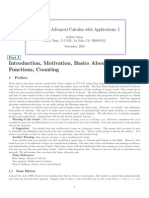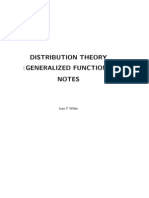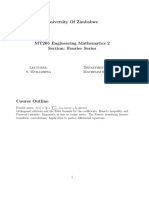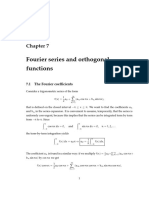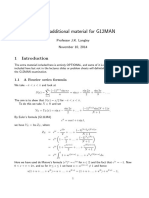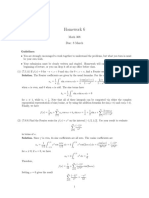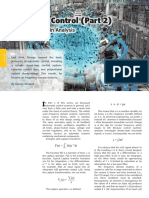The Dirac Delta Function Overview and Motivation: The Dirac Delta Function Is A Concept That Is Useful
Uploaded by
matrixx105The Dirac Delta Function Overview and Motivation: The Dirac Delta Function Is A Concept That Is Useful
Uploaded by
matrixx105Lecture 15 Phys 3750
The Dirac Delta Function
Overview and Motivation: The Dirac delta function is a concept that is useful
throughout physics. For example, the charge density associated with a point charge
can be represented using the delta function. As we will see when we discuss Fourier
transforms (next lecture), the delta function naturally arises in that setting.
Key Mathematics: The Dirac delta function!
I. Introduction
The basic equation associated with the Dirac delta function δ (x ) is
∫ δ (x) f (x)dx = f (0),
−∞
(1)
where f (x ) is any function that is continuous at x = 0 . Equation (1) should seem
strange: we have an integral that only depends upon the value of the function f (x ) at
x = 0 . Because an integral is "the area under the curve," we expect its value to not
depend only upon one particular value of x . Indeed, there is no function δ (x ) that
satisfies Eq. (1). However, there is another kind of mathematical object, known as a
generalized function (or distribution), that can be defined that satisfies Eq. (1).
A generalized function can be defined as the limit of a sequence of functions. Let's
see how this works in the case of δ (x ) . Let's start with the normalized Gaussian
functions
n
g n (x ) =
2
e − nx . (2)
π
Here n = 1 σ 2 , where σ is the standard Gaussian width parameter. These functions
are normalized in the sense that their integrals equal 1,
∞
∫ g (x)dx = 1
−∞
n (3)
for any value of n (>0). Let's now consider the sequence of functions for
n = 1, 2, 3,K ,
D M Riffe -1- 2/18/2009
Lecture 15 Phys 3750
1 2 100
g1 ( x ) = e − x , g 2 (x ) = e − 2 x , … , g100 ( x ) =
2 2 2
e −100 x , … (4)
π π π
What does this sequence of functions look like? We can summarize this sequence as
follows. As n increases
(a) g n (0) becomes larger;
(b) g n (x ≠ 0) eventually becomes smaller;
(c) the width of the center peak becomes smaller;
∞
(d) but ∫ g (x)dx = 1 remains constant.
−∞
n
The following figure plots some of the functions in this sequence.
20
n=1
n=4
n = 16
n = 64
15 n = 256
gn(x)
10
0
2 1 0 1 2
Let's now ask ourselves, what does the n = ∞ limit of this sequence look like? Based
on (a) through (d) above we would (perhaps simplistically) say
(a) g ∞ (0) = ∞ ;
(b) g n (x ≠ 0 ) = 0 ;
(c) the width of the center peak equals zero;
D M Riffe -2- 2/18/2009
Lecture 15 Phys 3750
(d) but ∫ g (x)dx = 1 .
−∞
∞
Note that (a) and (b) are not compatible with (d) if g ∞ ( x) is a function in the standard
sense, because for a function (a) and (b) would imply that the integral of g ∞ ( x) is zero.
So how should we think of this sequence of functions, then? Well, the sequence is
only really useful if it appears as part of an integral, as in, for example,
∞ ∞
∫ g (x) f (x)dx = lim ∫ e − nx f ( x ) dx .
2
lim n
n
π (5)
n→∞ n →∞
−∞ −∞
Let's calculate the integral, and then the limit in Eq. (5). The following figure should
help with the calculation.
15
g256(x)
f(x)
10
gn(x), f(x)
0
2 1 0 1 2
As n get large, g n (x ) = πn e − nx becomes narrower such that it only has weight very
2
close to x = 0 . Thus, as far as the integral is concerned, for large enough n only f (x )
at x = 0 is important. We can thus replace f (x ) by f (0) in the integral, which gives us
D M Riffe -3- 2/18/2009
Lecture 15 Phys 3750
∞ ∞
∫ − nx 2
f ( x ) dx = f (0 ) lim
∫ e − nx dx = f (0) lim 1 = f (0) (6)
2
lim n
π e n
π
n →∞ n →∞ n →∞
−∞ −∞
Thus, the integral on the lhs of Eq. (1) is really shorthand for the integral on the lhs of
Eq. (6), That is, the Dirac delta function is defined via the equation
∞ ∞
∫ δ ( x ) f ( x ) dx = lim
∫ e − nx f ( x ) dx (7)
n 2
n →∞ π
−∞ −∞
Now often (as physicists) we often get lazy and write
δ (x ) = lim e − nx , (8)
n 2
n →∞
π
but this is simply shorthand for Eq. (7). Eq. (8) really has no meaning unless the
2
function πn e − nx appears inside an integral and the limit lim appears outside the same
n →∞
integral. However, after you get used to working with the delta function, you will
rarely need to even think about the limit that is used to define it.
One other thing to note. This particular sequence of functions g n (x ) = πn e − nx that we
2
have used here is not unique. There are infinitely many sequences that can be used to
define the delta function. For example, we could also have defined δ (x ) via
1 sin (nx )
δ ( x ) = lim . (9)
n →∞ π x
The sequence of functions sin (nx ) (π x ) is illustrated in the figure at the top of the
next page.
Notice that the key features of both of these two difference sequences are expressed
by (a) – (d) at the top of page 5.
II. Delta Function Properties
There are a number of properties of the delta function that are worth committing to
memory. They include the following,
∞
∫ δ (x − x′) f (x)dx = f (x′),
−∞
(10)
D M Riffe -4- 2/18/2009
Lecture 15 Phys 3750
n=1
n=4
25
n=8
n = 16
n = 32
20
sin(nx)/(pi*x)
15
10
0
4 2 0 2 4
∫ δ ′(x) f (x)dx = − f ′(0)
−∞
(11)
δ (x a ) = a δ (x ) (12)
The proof of Eq. (10) is relatively straightforward. Let's change the integration
variable to y = x − x′ , dy = dx , which gives
∞ ∞
∫ δ (x − x′) f (x) dx = ∫ δ ( y ) f ( y + x′)dy .
−∞ −∞
(13)
Then using Eq. (1), we see that Eq. (10) is simply equal to f (x′) . QED.
Let's also prove Eq. (12). We do this in two steps, for a > 0 and then for a < 0 .
(i) First, we assume that a > 0 . Then
D M Riffe -5- 2/18/2009
Lecture 15 Phys 3750
∞ ∞
∫ δ (x a )dx = ∫ δ (x a )dx
−∞ −∞
(14)
Changing integration variable y = x a , dy = dx a , this last equation becomes
∞ ∞
∫ δ (x a )dx = a ∫ δ ( y )dy
−∞ −∞
(15)
and changing variables back to x via x = y , dx = dy gives
∞ ∞
∫ δ (x a )dx = a ∫ δ (x)dx
−∞ −∞
(16)
and so for a > 0 we have δ (x a ) = a δ (x ) .
(ii) We now assume a < 0 . Then we have
∞ ∞
∫ δ (x a )dx = ∫ δ (− x a )dx
−∞ −∞
(17)
Changing integration variable y = − x a , dy = − dx a , this last equation becomes
∞ −∞
∫ δ (x a )dx = − a ∫ δ ( y )dy
−∞ ∞
∞
∫
= a δ ( y ) dy
−∞
(18)
∞
∫
= a δ ( x ) dx
−∞
and so for a < 0 we also have δ (x a ) = a δ (x ) . QED.
We leave the proof of Eq. (11) as an exercise.
D M Riffe -6- 2/18/2009
Lecture 15 Phys 3750
III. Fourier Series and the Delta Function
Recall the complex Fourier series representation of a function f (x ) defined on
−L≤ x≤ L,
f (x ) = ∑c e
n = −∞
n
i nπx L
, (19a)
L
1
∫ f (x ) e
− inπx L
cn = dx . (19b)
2L
−L
Let's now substitute cn from Eq. (19b) into Eq. (19a). Before we do this we must
change the variable x in either Eq. (19a) or (19b) to something else because the
variable x in Eq. (19b) is just a (dummy) integration variable. Changing x to x′ in Eq.
(19a) and doing the substitution we end up with
∞ 1 L
f ( x′ ) = ∑
n = −∞ 2 L − L
f ( x ) e − inπx L dx ei nπx ′ L
∫
(20)
Let's now switch the integration and summation (assuming that this is OK to do).
This produces
L
1 ∞
f ( x ′) =
∫ ∑
−L
2L
n = −∞
e i nπ ( x′− x ) L f ( x ) dx
(21)
If we now compare Eq. (21) to Eq. (10), we see that we can identify another
representation of the delta function
∞
∑
1
δ ( x − x′ ) = e i nπ ( x′− x ) L (22)
2 L n = −∞
or setting x′ = 0 we have
∞
∑
1
δ (x ) = e −i nπx L (23)
2 L n = −∞
So how is this equation related to the delta function being defined as the limit of a
sequence of functions? Well, we can re-express Eq. (23) as a sequence of functions via
D M Riffe -7- 2/18/2009
Lecture 15 Phys 3750
∑
1
δ ( x ) = lim e −i nπx L . (24)
m →∞ 2 L
n=− m
∑
1
The following figure plots e −i nπx L for several values of m (for L = 2 ). Notice
2 L n=− m
that these functions are quite similar to the function sin (mx ) (π x ) plotted above. 1
m=2
40 m=4
m=8
m = 16
m = 32
30
Sum[exp(i*n*pi*x/l)]
20
10
0
2 1 0 1 2
However, there is one important difference between these two sequences of functions.
Because the functions e −i nπx L that appear in the sum in Eqs. (23) and (24) all repeat
with on an interval of length 2 L , Eq. (24) is actually a series of delta functions,
centered at x = 0, ± 2 L, ± 4 L, ± 6 L,K . This is illustrated in the next figure, where we
have expanded the x axis beyond the limits of − L to L . Thus, the equality expressed
by Eq. (23) or (24) is only valid on the interval − L ≤ x ≤ L .
1
We have changed the n to m in the sin (nx ) (π x ) functions because we are now using m to label the
functions in the sequence.
D M Riffe -8- 2/18/2009
Lecture 15 Phys 3750
m=2
40 m=4
m=8
m = 16
m = 32
30
Sum[exp(i*n*pi*x/l)]
20
10
0
6 4 2 0 2 4 6
Exercises
∞
*15.1 Equation (11), ∫ δ ′(x) f (x)dx = − f ′(0) , can be taken as the definition of the
−∞
derivative of the delta function. Treating the delta function as a normal function,
show that Eq. (11) is true. (Hint: use integration by parts.)
m
∑
1
*15.2 Show that the equation δ (x ) = mlim
→∞ 2 L
e −i nπx L can be re-expressed as
n=− m
m
nπx
∑
1
δ ( x ) = lim cos . This is perhaps more appealing because the delta function
m →∞ 2 L
n=− m L
is a real function and the rhs is now explicitly real.
*15.3 Find another sequence of functions, not based on either the Gaussian or
sin ( x ) x functions, that has as its limit the delta function.
D M Riffe -9- 2/18/2009
You might also like
- The Fourier Integral and Delta FunctionsNo ratings yetThe Fourier Integral and Delta Functions8 pages
- Notes On Integral Transforms: Unnati Akhouri Miranda House, Delhi University, New Delhi, 110007 September 6, 2016No ratings yetNotes On Integral Transforms: Unnati Akhouri Miranda House, Delhi University, New Delhi, 110007 September 6, 201618 pages
- Integral Transforms: Richard Earl (Edited, and Chapter 6 Added, by Sam Howison) Hilary Term 2019No ratings yetIntegral Transforms: Richard Earl (Edited, and Chapter 6 Added, by Sam Howison) Hilary Term 201958 pages
- Advance Engineering Mathematics E-Note PDFNo ratings yetAdvance Engineering Mathematics E-Note PDF77 pages
- 1B Methods Lecture Notes: Richard Jozsa, DAMTP Cambridge Rj310@cam - Ac.ukNo ratings yet1B Methods Lecture Notes: Richard Jozsa, DAMTP Cambridge Rj310@cam - Ac.uk36 pages
- On Fourier Transforms and Delta Functions: 3.1 Basic AnalogiesNo ratings yetOn Fourier Transforms and Delta Functions: 3.1 Basic Analogies15 pages
- The Motion of Wave Packets: Fourier AnalysisNo ratings yetThe Motion of Wave Packets: Fourier Analysis11 pages
- Fourier Series and Integrals: Project PHYSNET Physics Bldg. Michigan State University East Lansing, MINo ratings yetFourier Series and Integrals: Project PHYSNET Physics Bldg. Michigan State University East Lansing, MI12 pages
- Fourier Series and Periodicity: Cos Sin 2No ratings yetFourier Series and Periodicity: Cos Sin 28 pages
- Distribution Theory Generalized Functions Notes: Ivan F WildeNo ratings yetDistribution Theory Generalized Functions Notes: Ivan F Wilde66 pages
- FALLSEM2019-20 MAT3003 TH VL2019201006742 2019-09-27 Reference-Material-INo ratings yetFALLSEM2019-20 MAT3003 TH VL2019201006742 2019-09-27 Reference-Material-I8 pages
- University of Zimbabwe: Lecturer: S. Murambiwa Department: MathematicsNo ratings yetUniversity of Zimbabwe: Lecturer: S. Murambiwa Department: Mathematics15 pages
- Fourier Series, Sine Series, Cosine SeriesNo ratings yetFourier Series, Sine Series, Cosine Series9 pages
- Fourier Series and Orthogonal FunctionsNo ratings yetFourier Series and Orthogonal Functions18 pages
- 1 Orthogonality of Cosine, Sine and Complex ExponentialsNo ratings yet1 Orthogonality of Cosine, Sine and Complex Exponentials5 pages
- Fourier Transform Primer and Its Applications in Signal ProcessingNo ratings yetFourier Transform Primer and Its Applications in Signal Processing16 pages
- Limits and Continuity (Calculus) Engineering Entrance Exams Question BankFrom EverandLimits and Continuity (Calculus) Engineering Entrance Exams Question BankNo ratings yet
- National Chiao Tung University Application Form For Incoming Research StudentsNo ratings yetNational Chiao Tung University Application Form For Incoming Research Students3 pages
- Emotional Intelligence Sets Apart Good LeadersNo ratings yetEmotional Intelligence Sets Apart Good Leaders13 pages
- THE ROLE OF PRODUCT KNOWLEDGE AND KNOWLEDGE MANAGEMENT IN THE IMPLEMENTATION OF COPPERNo ratings yetTHE ROLE OF PRODUCT KNOWLEDGE AND KNOWLEDGE MANAGEMENT IN THE IMPLEMENTATION OF COPPER20 pages
- Optimizing Design & Control of Chilled Water PlantsNo ratings yetOptimizing Design & Control of Chilled Water Plants12 pages
- Automatic Control (Part 2) : Frequency Domain AnalysisNo ratings yetAutomatic Control (Part 2) : Frequency Domain Analysis4 pages
- Andrew (Balugawhale) Seidman Easy Game Volume III (137p)100% (8)Andrew (Balugawhale) Seidman Easy Game Volume III (137p)136 pages
- 4-5. Art, Copy - Creative Strategy-Ganjil2021-2022No ratings yet4-5. Art, Copy - Creative Strategy-Ganjil2021-2022163 pages
- Strategies For Feeding Patients With Dementia.18100% (1)Strategies For Feeding Patients With Dementia.189 pages
- Head-Driven Phrase Structure Grammar: July 2002No ratings yetHead-Driven Phrase Structure Grammar: July 20029 pages
- Schedule Line Delivery - Order Fulfillment - SAP LibraryNo ratings yetSchedule Line Delivery - Order Fulfillment - SAP Library3 pages
- Ielts Speaking A Collection of Common Topics: Unit 1 People Lesson 7 An Old Person You RespectNo ratings yetIelts Speaking A Collection of Common Topics: Unit 1 People Lesson 7 An Old Person You Respect8 pages
- Excel Functions of Decile and PercentileNo ratings yetExcel Functions of Decile and Percentile6 pages
- Notes On Integral Transforms: Unnati Akhouri Miranda House, Delhi University, New Delhi, 110007 September 6, 2016Notes On Integral Transforms: Unnati Akhouri Miranda House, Delhi University, New Delhi, 110007 September 6, 2016
- Integral Transforms: Richard Earl (Edited, and Chapter 6 Added, by Sam Howison) Hilary Term 2019Integral Transforms: Richard Earl (Edited, and Chapter 6 Added, by Sam Howison) Hilary Term 2019
- 1B Methods Lecture Notes: Richard Jozsa, DAMTP Cambridge Rj310@cam - Ac.uk1B Methods Lecture Notes: Richard Jozsa, DAMTP Cambridge Rj310@cam - Ac.uk
- On Fourier Transforms and Delta Functions: 3.1 Basic AnalogiesOn Fourier Transforms and Delta Functions: 3.1 Basic Analogies
- Fourier Series and Integrals: Project PHYSNET Physics Bldg. Michigan State University East Lansing, MIFourier Series and Integrals: Project PHYSNET Physics Bldg. Michigan State University East Lansing, MI
- Distribution Theory Generalized Functions Notes: Ivan F WildeDistribution Theory Generalized Functions Notes: Ivan F Wilde
- FALLSEM2019-20 MAT3003 TH VL2019201006742 2019-09-27 Reference-Material-IFALLSEM2019-20 MAT3003 TH VL2019201006742 2019-09-27 Reference-Material-I
- University of Zimbabwe: Lecturer: S. Murambiwa Department: MathematicsUniversity of Zimbabwe: Lecturer: S. Murambiwa Department: Mathematics
- 1 Orthogonality of Cosine, Sine and Complex Exponentials1 Orthogonality of Cosine, Sine and Complex Exponentials
- Fourier Transform Primer and Its Applications in Signal ProcessingFourier Transform Primer and Its Applications in Signal Processing
- A-level Maths Revision: Cheeky Revision ShortcutsFrom EverandA-level Maths Revision: Cheeky Revision Shortcuts
- Multiple Integrals, A Collection of Solved ProblemsFrom EverandMultiple Integrals, A Collection of Solved Problems
- Limits and Continuity (Calculus) Engineering Entrance Exams Question BankFrom EverandLimits and Continuity (Calculus) Engineering Entrance Exams Question Bank
- National Chiao Tung University Application Form For Incoming Research StudentsNational Chiao Tung University Application Form For Incoming Research Students
- THE ROLE OF PRODUCT KNOWLEDGE AND KNOWLEDGE MANAGEMENT IN THE IMPLEMENTATION OF COPPERTHE ROLE OF PRODUCT KNOWLEDGE AND KNOWLEDGE MANAGEMENT IN THE IMPLEMENTATION OF COPPER
- Optimizing Design & Control of Chilled Water PlantsOptimizing Design & Control of Chilled Water Plants
- Automatic Control (Part 2) : Frequency Domain AnalysisAutomatic Control (Part 2) : Frequency Domain Analysis
- Andrew (Balugawhale) Seidman Easy Game Volume III (137p)Andrew (Balugawhale) Seidman Easy Game Volume III (137p)
- 4-5. Art, Copy - Creative Strategy-Ganjil2021-20224-5. Art, Copy - Creative Strategy-Ganjil2021-2022
- Schedule Line Delivery - Order Fulfillment - SAP LibrarySchedule Line Delivery - Order Fulfillment - SAP Library
- Ielts Speaking A Collection of Common Topics: Unit 1 People Lesson 7 An Old Person You RespectIelts Speaking A Collection of Common Topics: Unit 1 People Lesson 7 An Old Person You Respect








